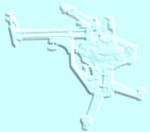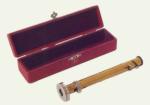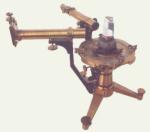

|
Another different slit University (2) |
 (1) (1)
|
||
|
Function To study the light interference. | |||
|
|||
|
Description The slit is obtained between two nickel silver plates with sharp and rectilinear edges. One of them is fixed, the other, sliding between two parallel guides, is controlled by a screw with a friction drum, divided into 50 equal parts, so that the opening is given in hundredths of millimetre. An antagonist spring eliminates any clearance of the screw and internal thread. The diaphragm that holds the split has two perpendicular cones, so that we can dispose the slit horizontally or vertically on its foot. The column allows 12 cm vertical displacements. | |||
 Menu
Menu
|
Function To study the light diffraction. |

| ||
|
|||
|
Description It is an interferometer formed by a glass or quartz plate with parallel surfaces in which multiple reflections take place. | |||
|
Function To study the dispersion of light. |

| ||
|
|||
|
Description The support has a variable height and it leans on a heavy basis that assures the stability of the prism. The prism is 8 cm long with a 3 cm section side. It is friction turning on its axis, hinged at right angle, and can assume any position. | |||
 Menu
Menu
|
Function To study the dispersion of light. |

| ||
|
|||
|
Description The support has a variable height and it leans on a heavy basis that assures the stability of the prism. The prism is 8 cm long with a 3 cm section side. It is friction turning on its axis, hinged at right angle, and can assume any position. | |||
|
Function To study the dispersion of light. |

| ||
|
|||
|
Description The support has a variable height and it leans on a heavy basis that assures the stability of the prism. The poliprism is composed of four kinds of glass with a different dispersive power. | |||
|
Function To study the spectrum of a luminous source. |

| ||
|
|||
|
Description It is formed by two tubes one sliding inside the other. In the first we have a slit, while in the second we have a lens and a prism of Amici. The light passes across the slit and goes to the prism by which it is dispersed without deviation. | |||
|
Function To study the spectrum of a luminous source. |

| ||
|
|||
|
Description The instrument is made in brass and it is formed by a disk held by a large pole that stands on a tripod with level screws. The fixed collimator and the tourning telescope are placed at the ends of two branches held by the central pole. The branches can turn around the pole. The prism is place on the centre of the disk. | |||
|
Function To study the spectrum of a luminous source. |

| ||
|
|||
|
Description The spectrograph is an instrument that records on a plate (spectrogram) the spectrum of the radiations under examination. It is particularly useful in the spectrography of the infrared and of the ultraviolet because we can use plates sensible to these radiations. The light goes into the collimator, crosses a prism and another collimator lens to arrive at a camera obscura. Inside this there is a fix frame on which another mobile slides vertically and on wich the plate is put. | |||
|
Function To study the spectrum of a luminous source. |

| ||
|
|||
|
Description Spectroscope at wavelength with constant deviation. The collimator and the telescope are placed on the U shaped branches of a basis held by a pole placed on a tripod. Between the collimator and the telescope the prism is placed, covered by a cylindrical shell with two holes. The focusing is obtained by changing the position of the collimator thanks to a micrometric screw. | |||
|
Function The interferential spectrometer is an instrument to study the fine structure of the light spectre. |

| ||
|
|||
|
Description The collimator and the telescope are placed on the branches of an L form basis supported by a pole that rises from a tripod. Between the two instruments we have the prism covered by a cylindrical container with two windows in correspondence of the collimator and of the telescope. We place the plate between the telescope and the prism. We can have the sharp image by varying the position of the telescope with a manometric screw. After crossing the collimator the light goes into a rectangular prism that disperses it. Then, it arrives with a certain inclination on a glass plate by which it is in part reflected and in part refracted. In this way we have two rays that arrive on the eyepiece where we can see the interference fringes. The study can regard only on spectre line if, before, we make the light pass through another spectroscope. | |||
|
Function To study the spectrum of a luminous source. |

| ||
|
|||
|
Description The instrument is used the light absorbed or reflected by a body in function of the wavelength. It is used in chemistry for the qualitative and quantitative analysis of substances. | |||